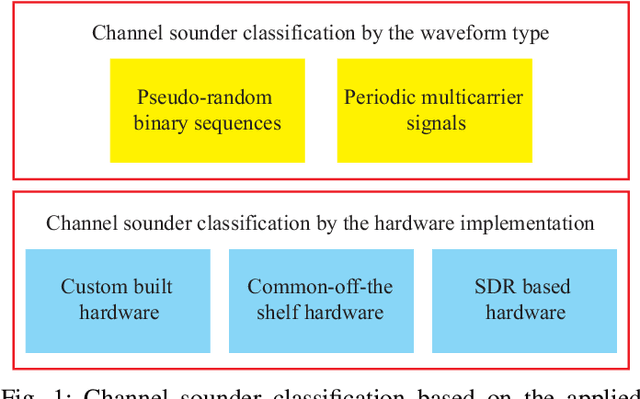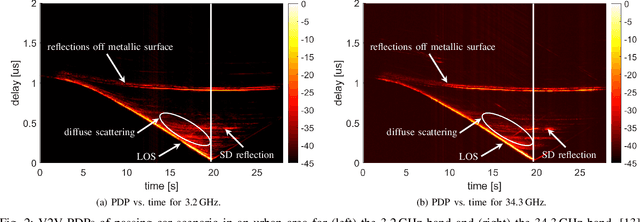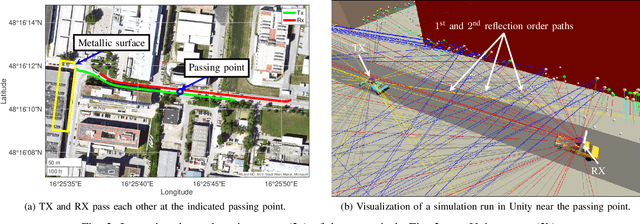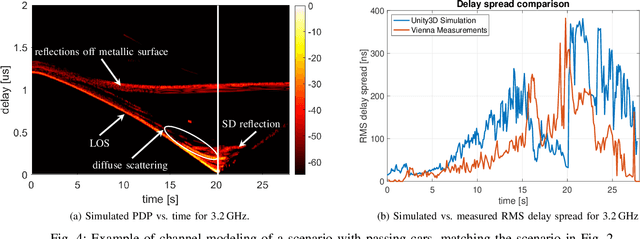Aleksei Fedorov
Distributed MIMO Measurements for Integrated Communication and Sensing in an Industrial Environment
Mar 04, 2024Abstract:Many concepts for future generations of wireless communication systems use coherent processing of signals from many distributed antennas. The aim is to improve communication reliability, capacity, and energy efficiency and provide possibilities for new applications through integrated communication and sensing. The large bandwidths available in the higher bands have inspired much work regarding sensing in the mmWave and sub-THz bands; however, the sub-6 GHz cellular bands will still be the main provider of wide cellular coverage due to the more favorable propagation conditions. In this paper, we present a measurement system and results of sub-6 GHz distributed MIMO measurements performed in an industrial environment. From the measurements, we evaluated the diversity for both large-scale and small-scale fading and characterized the link reliability. We also analyzed the possibility of multistatic sensing and positioning of users in the environment, with the initial results showing a mean-square error below 20 cm on the estimated position. Further, the results clearly showed that new channel models are needed that are spatially consistent and deal with the nonstationary channel properties among the antennas.
* 19 pages, 20 figure, Published in MDPI Sensors
Methodologies for Future Vehicular Digital Twins
Dec 15, 2023



Abstract:The role of wireless communications in various domains of intelligent transportation systems is significant; it is evident that dependable message exchange between nodes (cars, bikes, pedestrians, infrastructure, etc.) has to be guaranteed to fulfill the stringent requirements for future transportation systems. A precise site-specific digital twin is seen as a key enabler for the cost-effective development and validation of future vehicular communication systems. Furthermore, achieving a realistic digital twin for dependable wireless communications requires accurate measurement, modeling, and emulation of wireless communication channels. However, contemporary approaches in these domains are not efficient enough to satisfy the foreseen needs. In this position paper, we overview the current solutions, indicate their limitations, and discuss the most prospective paths for future investigation.
Enhanced EADF for the Characterization of Large-Scale Antenna Arrays
Sep 23, 2022



Abstract:Massive multiple-input multiple-output (MIMO) is a key technique for fifth-generation (5G) and beyond communications. Therefore, accurate characterization of the responses of the large-scale antenna arrays at an arbitrary direction is critical. The effective aperture distribution function (EADF) can provide an analytic description of an antenna array based on a full-sphere measurement of the array in an anechoic chamber. However, as the aperture of an array becomes significantly larger, application of the EADF requires very dense spatial samples due to the large distance-offsets of the array elements to the reference point in the anechoic chamber. This leads to a prohibitive measurement time and a high computational complexity of EADF. In this paper, we first present the EADF applied to large-scale arrays, followed by an analytical analysis of the issue caused by the large array aperture. To solve this issue, an enhanced low-complexity EADF is proposed with a low complexity that is only considering the intrinsic characteristics of each array element rather than the aperture size of the array. Moreover, a measurement campaign conducted at the frequency band of 27-30\,GHz using a relatively large planar array is introduced, where the proposed enhanced EADF is applied and validated.
 Add to Chrome
Add to Chrome Add to Firefox
Add to Firefox Add to Edge
Add to Edge